Recent Posts
Mold and Home Value: How Infestations Affect Resale
3/13/2024 (Permalink)
As homeowners, we invest a significant amount of time and money in maintaining and improving our properties. However, there's a silent intruder that can significantly impact the resale value of your home—mold. In this blog post, we'll delve into the connection between mold infestations and home value and provide insights on how you can address this issue effectively.
Understanding the Impact
Potential homebuyers are increasingly vigilant about the condition of a property they are considering. Mold infestations not only affect the aesthetic appeal of a home but can also lead to structural damage over time. This makes it crucial to address mold issues promptly to maintain or increase your home's resale value.
Visible and Hidden Mold
Mold is not always visible to the naked eye. While some infestations are apparent, others may be hidden behind walls or beneath flooring. Both types can impact your home's value, and it's essential to address the issue comprehensively. Regular inspections, especially in moisture-prone areas like basements and bathrooms, can help identify and mitigate mold problems early on.
Professional Inspection and Remediation
To ensure a thorough assessment of your home's mold situation, consider hiring a professional mold inspection service like SERVPRO®. Our trained technicians can identify hidden mold, assess the extent of the infestation, and recommend effective remediation strategies. Professional remediation not only improves the overall indoor air quality but also safeguards your home's value.
Preventive Measures
Prevention is key when it comes to mold and home value. Implementing measures to control moisture levels in your home, such as proper ventilation and timely repairs, can significantly reduce the risk of mold growth. Regularly inspecting your property for signs of water damage and promptly addressing any issues can save you from potential headaches during resale.
Disclose and Document
If you've experienced a mold problem in the past, it's important to disclose this information to potential buyers. Being transparent about past mold issues and providing documentation of professional remediation efforts can build trust and demonstrate your commitment to maintaining a mold neutral home.
In the competitive real estate market, maintaining or enhancing your home's resale value is crucial. By understanding the impact of mold infestations and taking proactive measures, you can ensure that your property stands out positively in the eyes of potential buyers. For professional mold inspection and remediation services, trust SERVPRO to help safeguard your home's value and ensure a smooth resale process.
How to Identify and Address Hidden Water Leaks
2/19/2024 (Permalink)
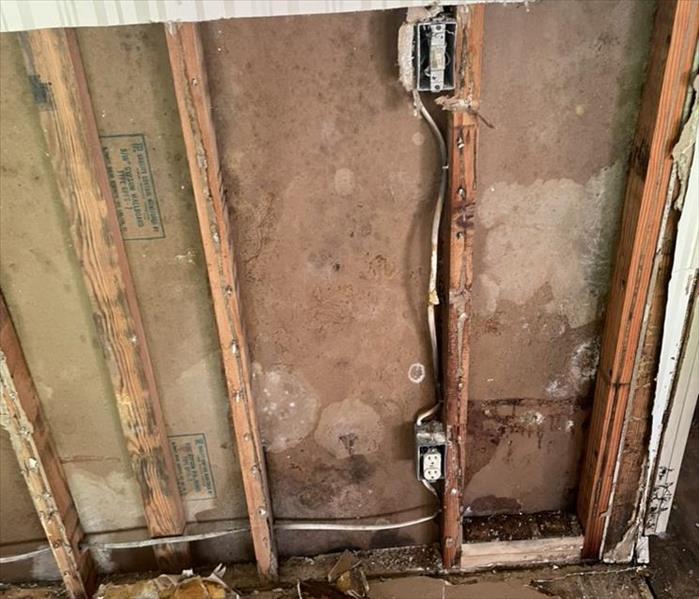 Identifying and addressing hidden water leaks quickly is essential to protect your property from extensive damage and costly repairs.
Identifying and addressing hidden water leaks quickly is essential to protect your property from extensive damage and costly repairs.
Water leaks, often concealed within walls, ceilings, or underground, can silently wreak havoc on your property, leading to structural damage, mold growth, and even increased utility bills. Identifying and addressing hidden water leaks early is crucial in preventing extensive damage.
Keep an Eye on Your Water Meter
Monitor your water meter regularly, especially when no water is in use. A sudden increase in readings could indicate an undetected leak. Turn off all water sources and check if the meter continues to register water usage.
Check for Visible Signs of Water Damage
Look out for water stains, discoloration, or peeling paint on walls, ceilings, or floors. Soft or sagging drywall may also indicate hidden water leaks. Investigate any musty odors, which could be a sign of mold due to water damage.
Inspect Plumbing Fixtures and Appliances
Check for leaks around plumbing fixtures, such as sinks, toilets, and showers. Inspect appliances like dishwashers, refrigerators, and washing machines for any signs of water accumulation or moisture.
Use a Water Leak Detection Device
Consider using water leak detection devices or sensors that can alert you to leaks by detecting changes in moisture levels. Place these devices near potential leak sources or in areas prone to water damage.
Examine Outdoor Areas and Irrigation Systems
Check outdoor faucets, hoses, and irrigation systems for leaks or pooling water. Ensure proper drainage away from the foundation to prevent water from seeping into your property.
Consult Professional Water Leak Detection Services
If you suspect a hidden water leak but cannot identify its source, seek assistance from professionals like SERVPRO of North Fort Myers. Our team of experts utilizes specialized equipment to pinpoint hidden leaks without causing unnecessary damage.
Quickly Address Identified Leaks
Upon identifying a water leak, take immediate action to fix it. Whether it's repairing a faulty pipe, replacing a damaged fixture, or sealing gaps, swift intervention can prevent further damage and mitigate risks.
Identifying and addressing hidden water leaks quickly is essential to protect your property from extensive damage and costly repairs. At SERVPRO®, we specialize in water damage restoration and are ready to assist you in mitigating the effects of hidden leaks. Contact SERVPRO® for professional water leak detection and restoration services. Let us help you protect your property against the damaging effects of hidden water leaks.
Trust SERVPRO of North Fort Myers – Your Partner in Identifying and Addressing Hidden Water Leaks for a Safer, Healtheir Home.
Understanding Wind Damage
1/8/2024 (Permalink)
Powerful winds can strike without warning, leaving in their wake a daunting path of destruction. One key aspect to navigating post-storm recovery, however, is understanding the extent of what wind damage can do. From SERVPRO®, specialists in wind damage restoration here's what you need to know.
Types of Wind Damage
- Roof Damage: Wind can lift shingles, creating pockets where water can later seep in. It can also hurl debris, such as branches, which can cause severe structural damage.
- Window and Door Damage: Strong gusts of wind can break windows or cause warping in door frames allowing elements like rain or hail to infiltrate your home.
- Structural Damage: In extreme cases, strong winds can cause structural damage to walls, outdoor sheds, or garages, compromising the strength of these elements.
- Downed Trees and Limbs: Storm winds can break tree limbs or uproot entire trees, causing damage to anything in their path, including houses, cars, and power lines.
- Vehicle Damage: Vehicles parked outdoors during a windstorm are at risk of being hit by flying debris or falling tree branches.
Tips for Mitigating Wind Damage
- Secure Loose Items: Anything from trash cans to patio furnishings can become dangerous projectiles in high winds. Secure loose items or move them indoors before a windstorm.
- Trim Trees: Regular pruning of tree branches can prevent them from falling onto your property.
- Inspect Your Roof: Conduct a regular check of your roof for loose or missing shingles, as these can be quickly stripped by wind, leaving your home vulnerable to rainfall.
- Install Impact-Resistant Windows: These windows are designed to withstand high winds and can offer extra protection against storm damage.
In the aftermath of a windstorm, SERVPRO of North Fort Myers is always ready to help. With our 24/7 service, we are equipped to handle all dimensions of wind damage restoration, returning your home or business to its pre-disaster state in the shortest possible time. Our experts are known for transforming storm-affected properties back to their original condition - "Like it never even happened."
Why Do I Need a Professional to Handle Fire Restoration?
12/16/2023 (Permalink)
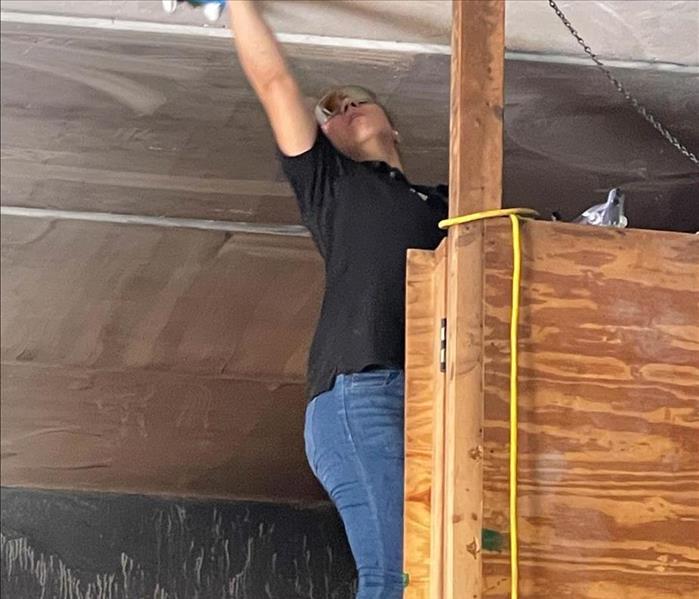 Fire damage is not just about visible destruction but also includes hidden dangers that can worsen over time if not properly addressed.
Fire damage is not just about visible destruction but also includes hidden dangers that can worsen over time if not properly addressed.
Facing a fire in your home is a devastating experience, and the aftermath can be overwhelming. Fire damage is not just about visible destruction but also includes hidden dangers that can worsen over time if not properly addressed. In this blog, we'll explore the critical reasons why you need a professional to handle fire restoration and how SERVPRO® of North Fort Myers can help.
Experience Matters
Fire damage restoration is a specialized field that requires knowledge and expertise. Professionals have the experience and training to handle the unique challenges that arise after a fire. They understand the behavior of smoke, soot, and fire-damaged materials, which is crucial for effective restoration.
Thorough Assessment
Professionals start with a comprehensive assessment of the damage. This not only includes what's immediately visible but also hidden issues such as structural damage, soot residue, and potential health hazards. A thorough assessment is essential for a successful restoration.
Safety First
After a fire, safety is paramount. Professionals are equipped to ensure your safety and the safety of your family throughout the restoration process. They know how to handle potentially hazardous materials and mitigate risks effectively.
Specialized Equipment
Professional restoration companies like SERVPRO® have access to specialized equipment that's essential for efficient and effective restoration. This equipment includes industrial-strength cleaners, deodorizers, and tools to address different aspects of fire damage.
Preventing Further Damage
After a fire, secondary damage can occur due to lingering soot and smoke. Professionals take steps to prevent further damage and halt the deterioration of your property. This is crucial for minimizing restoration costs.
Insurance Assistance
Dealing with insurance companies can be a complex and time-consuming process. Professionals have experience working with insurance companies and can help you navigate the claims process, ensuring you get the coverage you deserve.
Restoration Expertise
Restoring your home to its pre-fire condition involves cleaning, repairing, and often rebuilding. Professionals have the expertise to restore your property effectively, ensuring it looks and feels like home again.
Peace of Mind
Hiring professionals for fire restoration provides peace of mind. You can trust that your home is in capable hands, allowing you to focus on getting your life back to normal.
In the aftermath of a fire, the decision to hire a professional for fire restoration can make all the difference in the outcome. The experience, safety measures, equipment, and expertise that professionals bring to the table are invaluable in restoring your home to its former glory. If you're in need of fire restoration services, don't hesitate to contact SERVPRO® of North Fort Myers for expert assistance and a faster return to normalcy.
Selecting Safe Mold Cleaning Solutions for Your Home
11/14/2023 (Permalink)
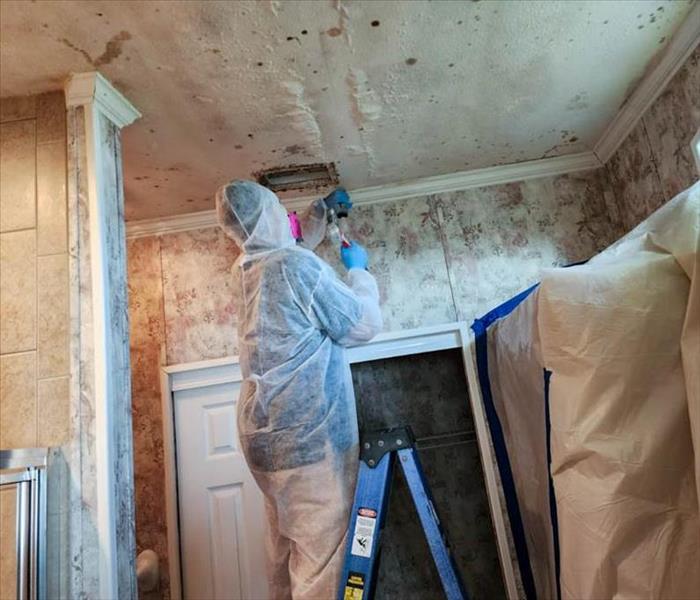 For extensive mold issues, don't hesitate to contact our local SERVPRO® of North Fort Myers team.
For extensive mold issues, don't hesitate to contact our local SERVPRO® of North Fort Myers team.
When addressing mold problems in your Fort Myers home, choosing safe and effective cleaning products is essential. In this blog, we'll explore safe mold cleaning products that are ideal for tackling mold issues in your sunny Fort Myers home.
Why Choose Safe Mold Cleaning Products?
Before delving into specific products, it's crucial to understand the importance of opting for safe mold-cleaning products. Safety should always be a top priority, and this includes ensuring that the products you use are non-toxic and environmentally friendly. The goal is to effectively eliminate mold without compromising the well-being of your family or the local environment.
Safe Mold Cleaning Products for Your Fort Myers Home
White Vinegar
White vinegar is a natural and safe cleaning agent that can effectively remove mold. Mix equal parts of white vinegar and water in a spray bottle and apply it to the mold-affected areas. Allow it to sit for a few hours before scrubbing and wiping away the mold.
Baking Soda
Baking soda is not only a safe cleaner but also a natural deodorizer. Create a paste by mixing baking soda with a small amount of water and apply it to the moldy surfaces. Scrub gently, then rinse and wipe clean.
Hydrogen Peroxide
Hydrogen peroxide is an effective mold remover and disinfectant. It's safe for both your family and the environment. Use a 3% hydrogen peroxide solution in a spray bottle and apply it to moldy areas. Allow it to sit for 10-15 minutes, then scrub and wipe away the mold.
Tea Tree Oil
Tea tree oil is a natural antifungal and antibacterial agent. Mix two teaspoons of tea tree oil with two cups of water and spray it on moldy surfaces. Leave it to dry without rinsing. The pleasant aroma also serves as a natural deodorizer.
Commercial Eco-Friendly Mold Cleaners
If you prefer a ready-made solution, many commercial eco-friendly mold cleaning products are available. Look for products that have earned certifications for being safe and environmentally friendly. These products are specially formulated to remove mold effectively while meeting safety standards.
Safety Precautions When Using Mold Cleaning Products
When working with mold cleaning products, it's crucial to take safety precautions:
- Always wear protective gear such as gloves, goggles, and a mask to avoid contact with mold spores and cleaning products.
- Ensure proper ventilation by opening windows and using fans to dissipate fumes.
- Keep cleaning products out of reach of children and pets.
- Follow the manufacturer's instructions for each product.
When addressing mold problems in your Fort Myers, FL home, safety should be your top priority. Whether you choose natural remedies like vinegar, baking soda, and essential oils or prefer commercial eco-friendly mold cleaners, always remember to follow safety precautions when using these products.
For extensive mold issues or situations where safety is a concern, don't hesitate to contact our local SERVPRO® of North Fort Myers team. We have the expertise and equipment to handle mold remediation safely and effectively.
IICRC Standards for Water Damage Restoration
10/9/2023 (Permalink)
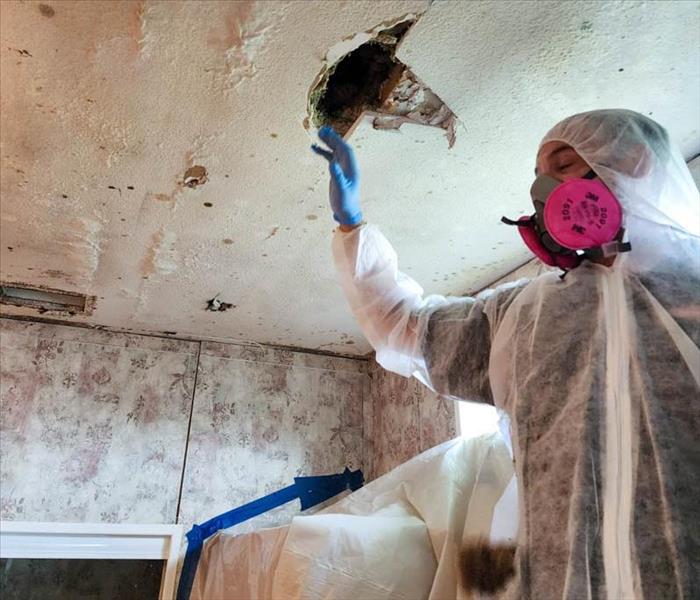 Understanding the IICRC standards for water damage restoration is essential when selecting a restoration company for your Ft. Myers, FL, property.
Understanding the IICRC standards for water damage restoration is essential when selecting a restoration company for your Ft. Myers, FL, property.
When faced with water damage in your Ft. Myers, FL, property, it's crucial to entrust the restoration process to professionals who adhere to industry standards. The Institute of Inspection, Cleaning and Restoration Certification (IICRC) is the foremost authority in the field of water damage restoration. In this blog, we explore the importance of the IICRC standards and how they ensure effective and thorough restoration for your property.
1. What Are the IICRC Standards?
The IICRC establishes guidelines and best practices for the water damage restoration industry. These standards are developed by industry experts and are widely recognized as the benchmark for quality and professionalism. Adhering to these standards ensures that restoration professionals provide consistent, high-quality services that meet or exceed customer expectations.
2. Comprehensive Training and Certification
To uphold the IICRC standards, SERVPRO® technicians undergo extensive training and certification programs. Our professionals receive specialized instruction in water damage restoration, structural drying techniques, mold remediation, and much more. This ensures that they possess the knowledge and expertise necessary to handle any water damage situation effectively.
3. Proper Assessment and Documentation
One of the key aspects of the IICRC standards is conducting a proper assessment and documenting the extent of the water damage. SERVPRO® technicians follow a systematic approach, evaluating the affected areas, identifying the source of the water intrusion, and documenting the damage comprehensively. This documentation plays a crucial role in insurance claims and can ensure that you receive the maximum compensation you are entitled to.
4. Advanced Equipment and Techniques
The IICRC standards emphasize the use of advanced equipment and techniques during the restoration process. SERVPRO® of North Fort Myers follows these guidelines and utilizes state-of-the-art equipment to extract water, dry affected areas, and restore your property to its pre-damage condition. Our technicians are trained in employing specialized techniques to mitigate water damage efficiently and prevent further issues, such as mold growth or structural deterioration.
5. Ongoing Education and Adaptation
The water damage restoration industry is constantly evolving, and the IICRC standards are regularly updated to reflect the latest advancements and best practices. SERVPRO® is committed to staying at the forefront of the industry by participating in ongoing education programs. This ensures that our technicians are knowledgeable about the latest techniques, technologies, and safety protocols, guaranteeing the highest level of service for our customers.
Understanding the IICRC standards for water damage restoration is essential when selecting a restoration company for your Ft. Myers, FL, property. By adhering to these standards, SERVPRO® of North Fort Myers ensures that your property is restored with the utmost care, professionalism, and efficiency. Our highly-trained technicians follow the guidelines set by the IICRC, utilizing advanced equipment and techniques to mitigate the damage and restore your property to its pre-damage condition. Trust SERVPRO® for all your water damage restoration needs, and experience the highest standard of service in the industry.
Weather Alerts and Emergency Notifications to stay Informed about Severe Weather
9/25/2023 (Permalink)
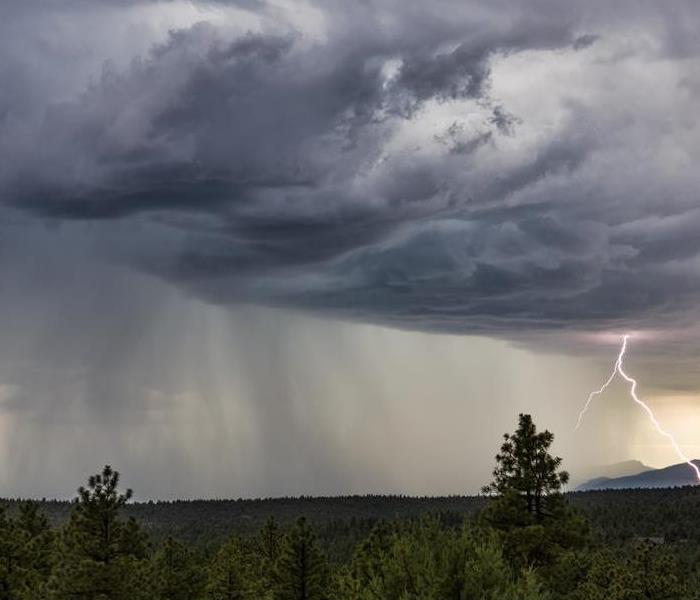 When it comes to severe weather be weather alert with technology to protect yourself and family.
When it comes to severe weather be weather alert with technology to protect yourself and family.
Severe weather events, such as hurricanes, tornadoes, and thunderstorms, can strike unexpectedly in the Southeast region. Staying informed about these weather conditions is vital for ensuring personal safety and preparedness. In this blog post, we will explore the different ways you can receive weather alerts and emergency notifications in the Southeast, enabling you to stay one step ahead and make informed decisions during severe weather events.
Local Weather Apps and Websites
In today's digital age, local weather apps and websites are invaluable tools for staying informed about weather conditions in your area. These services provide real-time weather updates, radar images, severe weather alerts, and forecasts specific to your location. Popular weather apps and websites include The Weather Channel, AccuWeather, and the National Weather Service (NWS). By downloading these apps or visiting their websites, you can access the latest weather information at your fingertips.
Mobile Alerts and Text Messages
Mobile alerts and text messages are another effective way to receive weather notifications in the Southeast. Most wireless carriers provide free emergency alert services that automatically deliver important weather information to your mobile device. These alerts are issued by government agencies and weather organizations, ensuring that you receive critical updates directly to your phone. Ensure that you have enabled emergency alerts on your mobile device settings to receive these notifications.
NOAA Weather Radio
NOAA Weather Radio (NWR) is a nationwide network of radio stations that provide continuous weather information 24/7. These stations broadcast weather forecasts, severe weather watches, warnings, and other emergency messages. NOAA Weather Radio receivers are available for purchase and are an excellent investment for staying informed during severe weather events, especially if you live in an area prone to power outages or have limited access to internet services.
Social Media and Online Communities
Social media platforms, such as Twitter and Facebook, have become crucial sources of information during severe weather events. Many local news stations, emergency management agencies, and meteorologists actively share weather updates, alerts, and emergency notifications through their social media accounts. Following these accounts and engaging with online communities dedicated to weather updates can help you stay informed, gain real-time insights, and access valuable resources during severe weather events.
Local News and Radio Stations
Traditional media sources, such as local news stations and radio stations, remain reliable and accessible channels for receiving weather alerts and emergency notifications in the Southeast. Pay attention to weather reports and news bulletins during severe weather events. Many news stations now have mobile apps and websites that offer weather updates and live streaming, providing additional options for staying informed.
When it comes to severe weather events in the Southeast, staying informed is paramount for your safety and preparedness. By utilizing local weather apps and websites, enabling mobile alerts, investing in a NOAA Weather Radio, and following social media accounts, you can receive timely weather alerts and emergency notifications. Remember to always have multiple sources of information and to seek shelter or evacuate when instructed by local authorities. By staying informed, you can make well-informed decisions and protect yourself and your loved ones during severe weather events.
Counting the Costs: Understanding the Potential Revenue Loss After a Fire Damage
9/12/2023 (Permalink)
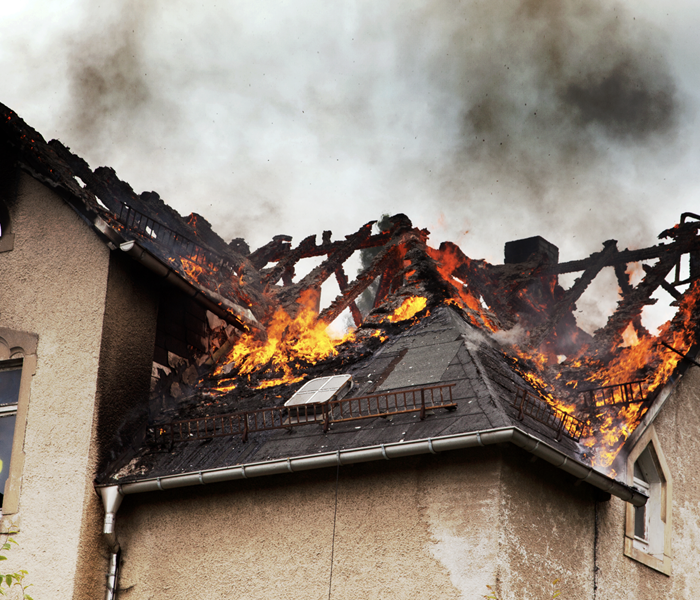 Hire a fire restoration expert for recovery after a fire loss.
Hire a fire restoration expert for recovery after a fire loss.
Experiencing a fire at your business can be a devastating and traumatic event. Apart from the obvious physical damage, the financial implications can be significant. A fire can disrupt operations, cause inventory loss, and even result in temporary closure. In this blog post, we will explore the potential revenue loss that can occur after a fire damage and how to mitigate its impact.
Temporary closure and loss of revenue
Following a fire, it is common for businesses to temporarily cease operations while the damage is assessed, repairs are made, and the premises are deemed safe. This forced closure can lead to a substantial loss in revenue, especially if the downtime stretches for an extended period. The length of closure will vary depending on the severity of the fire and the time needed for repairs.
During the period of closure and even after reopening, some customers may be hesitant to return. The disruption caused by the fire may lead them to seek alternatives or simply lose trust in your business. Rebuilding customer confidence and reestablishing your reputation will take time and effort, resulting in a potential loss of customers and a decrease in revenue.
Inventory and equipment damage
In a fire, inventory, equipment, and other assets can be severely damaged, or in some cases, completely destroyed. This loss not only impacts your ability to serve customers but also represents a significant financial setback. Restocking inventory and replacing damaged equipment can be costly and may further delay business operations.
It is important to review your insurance policies to understand the coverage provided for fire damage. Business interruption insurance can help mitigate the revenue loss during the closure period. This type of insurance typically covers lost income, ongoing expenses (such as rent and utilities), and additional expenses incurred due to the fire.
Disaster recovery and contingency planning
In order to minimize revenue loss and ensure a quicker recovery, having a comprehensive disaster recovery and contingency plan in place is crucial. This includes, but is not limited to, regular backups of data and important documents, off-site storage of sensitive information, and having emergency contact information easily accessible. By having these plans in place, you can mitigate the impact of a fire on your revenue and resumption of operations.
After a fire, it is advisable to work with fire restoration and recovery experts who can assess the extent of the damage and provide guidance on the steps needed for a full recovery. They can assist in salvaging items, cleaning affected areas, and restoring your premises to a safe and functional state. Time is of the essence, as quick action can help minimize revenue loss and expedite the reopening of your business.
In conclusion, the potential revenue loss after a fire damage can be significant and far-reaching. Temporary closure, loss of customers and reputation, inventory damage, and equipment replacement are just a few of the financial challenges that businesses may face. However, by having appropriate insurance coverage, implementing robust disaster recovery plans, and seeking professional assistance, it is possible to mitigate the impact and recover more swiftly. Being prepared and taking proactive steps before a fire occurs is essential to ensure the continuity and financial stability of your business.
What Can Cause a Flooded Basement? Exploring Common Culprits
7/17/2023 (Permalink)
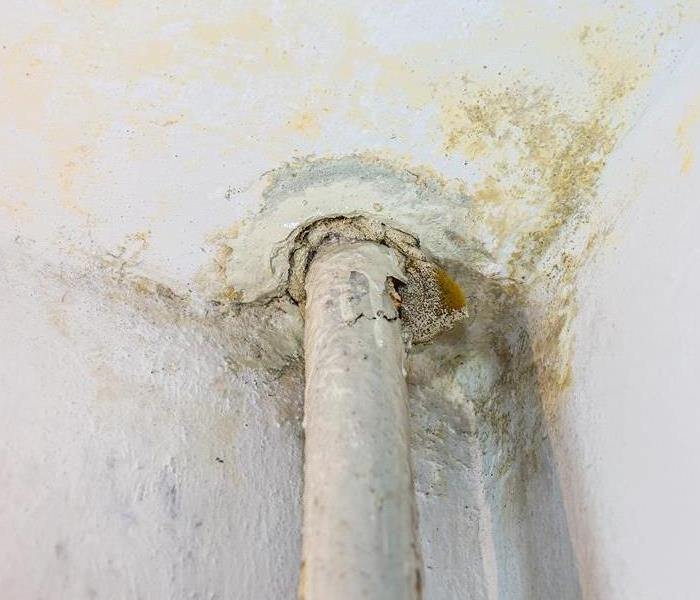 Regular maintenance, inspections, and timely repairs are key to protecting your basement from water damage.
Regular maintenance, inspections, and timely repairs are key to protecting your basement from water damage.
A flooded basement can be a homeowner's worst nightmare. Not only does it create a mess, but it can also lead to significant property damage and pose potential health risks. Understanding the common causes of basement flooding is essential for homeowners to take preventive measures and minimize the risk. In this blog post, we will explore several factors that can cause a flooded basement, providing valuable insights to help you protect your home.
Heavy rainfall and poor drainage
One of the most common causes of basement flooding is heavy rainfall. When the ground becomes saturated with water, excess water can seep into your basement through cracks in the foundation or windows. Poorly designed or clogged gutters and downspouts can also contribute to water pooling around the foundation, increasing the likelihood of basement flooding.
Foundation cracks and leaks
Cracks in the foundation walls or floor provide an easy entry point for water to infiltrate your basement. Over time, natural settlement, soil pressure, or temperature fluctuations can cause the foundation to develop cracks. Additionally, hydrostatic pressure from groundwater can push water through foundation walls. Regular inspections and timely repairs of foundation cracks are crucial to prevent basement flooding.
Faulty or overwhelmed sump pump
A sump pump is designed to pump out excess water from your basement, preventing flooding. However, if the pump is not functioning correctly or becomes overwhelmed due to excessive water intrusion, it can lead to a flooded basement. Regular maintenance, including testing the sump pump, cleaning the pit, and ensuring proper discharge, is essential to keep it in optimal working condition.
Burst or leaking pipes
Plumbing issues, such as burst pipes or leaking supply lines, can cause significant water damage in your basement. These issues can result from freezing temperatures, aging pipes, or poor installation. Regularly inspecting your plumbing system and addressing any leaks or weak spots promptly can help prevent basement flooding due to pipe-related issues.
Sewer backups
Sewer backups can occur when the municipal sewer system becomes overwhelmed by heavy rainfall or blockages. When the sewer line is unable to handle the excess water or waste, it can cause sewage to back up into your basement through floor drains or toilets. Installing a backwater valve and avoiding flushing inappropriate items down the drains can help reduce the risk of sewer backups.
Improperly graded landscaping
The grading around your home plays a vital role in directing water away from the foundation. If the slope of your yard is incorrect or the landscaping is poorly designed, it can lead to water pooling around the foundation, increasing the chances of basement flooding. Ensuring proper grading and implementing appropriate landscaping measures, such as installing French drains or rain gardens, can help prevent water from seeping into your basement.
A flooded basement can be a homeowner's nightmare, but understanding the common causes can help you take proactive measures to prevent such occurrences. Whether it's heavy rainfall, foundation issues, sump pump failures, plumbing problems, sewer backups, or landscaping concerns, addressing these factors can significantly reduce the risk of basement flooding. Regular maintenance, inspections, and timely repairs are key to safeguarding your basement and protecting your property from water damage.
Navigating the Waiting Period: Steps to Take Before the Insurance Adjuster's Evaluation
6/18/2023 (Permalink)
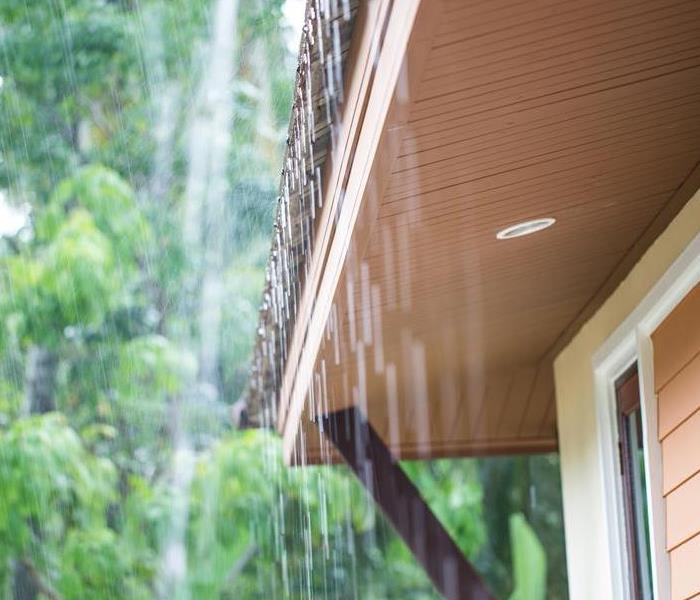 While waiting for insurance adjusters to assess storm damage, taking proactive steps is essential.
While waiting for insurance adjusters to assess storm damage, taking proactive steps is essential.
When your property suffers storm damage, it's important to act swiftly and notify your insurance company to initiate the claims process. However, waiting for insurance adjusters to assess the damage and process your claim can take time. In this blog, we'll explore practical steps you can take to protect your property, ensure your safety, and expedite the recovery process while awaiting the arrival of insurance adjusters.
Why You Shouldn’t Wait
When your property has been affected by storm damage, it's important not to wait for the insurance adjuster to arrive before taking action. Immediate action is crucial to mitigate further damage and ensure the safety of your property and its occupants. Storm damage, such as roof leaks or broken windows, can allow water to penetrate your home, leading to extensive water damage and potential mold growth. By taking prompt measures to protect your property, such as covering damaged areas, removing debris, and drying out affected spaces, you can prevent additional harm and demonstrate your commitment to mitigating the loss. Remember, your insurance adjuster will still need documentation and evidence of the damage, so it's essential to document everything through photographs and detailed descriptions. Acting promptly not only safeguards your property but also expedites the recovery process and ensures a smoother insurance claim experience. Let's dive in and discover what to do in the meantime.
Document the Damage
While waiting for insurance adjusters, it's crucial to thoroughly document the storm damage for your insurance claim. Take detailed photographs or videos of the affected areas, including structural damage, debris, and personal belongings. Make a comprehensive list of damaged items, noting their approximate value and any relevant details. This documentation will serve as valuable evidence during the claims process, helping ensure a fair assessment of the damage and a prompt settlement.
Mitigate Further Damage
To prevent further deterioration of your property, it's important to take immediate action to mitigate any potential secondary damage. If safe to do so, cover damaged areas with tarps or boards to protect against water intrusion. Clear debris, fallen branches, and any hazardous materials from your property. Additionally, turn off electricity and water supplies if you suspect any damage to electrical or plumbing systems. By taking these proactive measures, you can minimize the risk of additional harm to your property.
Maintain Open Communication
While waiting for insurance adjusters, maintain open and frequent communication with your insurance company. Keep a record of all interactions, including names, dates, and details discussed. Update your insurance provider with any significant developments or changes to the property's condition. Clear communication will help ensure that your claim progresses smoothly and that any necessary additional information or documentation is provided promptly.
Seek Professional Assistance
Engaging the services of a professional disaster restoration company can be invaluable while waiting for insurance adjusters. These experts specialize in storm damage restoration and can provide immediate assistance and guidance. They will conduct a thorough assessment of the damage, offer temporary repairs, and provide an estimate for the restoration work. Their expertise can help streamline the claims process by providing detailed documentation, estimates, and expert opinions to support your insurance claim.
Keep Detailed Records
Maintain meticulous records throughout the entire process. Keep track of all expenses related to temporary repairs, hotel stays, and additional living costs if your property is uninhabitable. Retain receipts, invoices, and any other relevant documents that demonstrate the extent of the damage and the expenses incurred. These records will help ensure that you are properly reimbursed for eligible expenses when settling your insurance claim.
While waiting for insurance adjusters to assess storm damage, taking proactive steps is essential. Documenting the damage, mitigating further harm, maintaining open communication, seeking professional assistance, and keeping detailed records will help expedite the recovery process and ensure a fair settlement for your insurance claim.




 24/7 Emergency Service
24/7 Emergency Service







